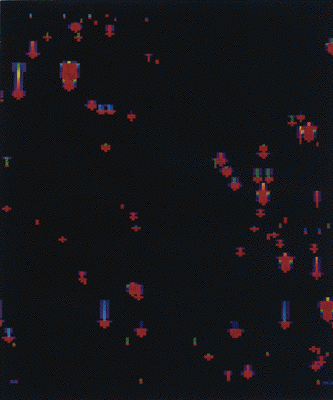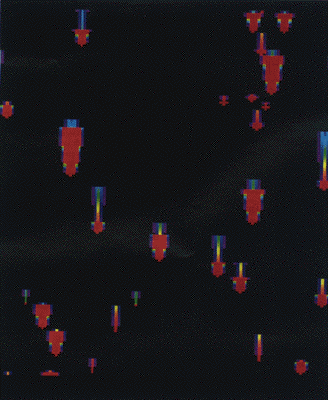
We have discovered a universal dynamical property in discrete systems (like QCA or CML) which we call fractal evolution.
It is observed in lattice models if any additional temporal feedback operation is introduced (involving some memory of the system’s states or some randomly generated mechanism) and if a normalization procedure after each time step is performed. Fractal evolution is characterized by a power-law behavior of a system’s order parameter with regard to a resolution-like parameter which controls the deviation from an undisturbed (i.e., feedback-less) system’s evolution, and it provides a dynamically invariant measure for the emerging spatio-temporal patterns. We call the latter the fractal evolution exponent to distinguish it from the fractal dimension of a static «object». As opposed to the scale invariance of the pattern of such a static object, our power law exponent characterizes the scale invariance of the pattern generation mechanism. Although our power law exhibits features similar to self-organized critical phenomena, it is not at all identical with them. It can thus be applied to systems showing power law behaviour without the requirement of their overall state being critical.

Finally, if in a further step an intrinsic change of above-mentioned resolution-like parameter during the systems evolution is implemented, one observes a self-organized growth of the order parameter. This is characterized as hierarchically emergent fractal evolution with different levels of pattern formation intrinsically emerging during the systems evolution.
The evolution of evolution
We have applied the phenomenon of HEFE within a simple toy-model of biological macroevolution. (Similarly, applications may be investigated for economics.) Our model exhibits both the property of punctuated equilibrium and the dynamics of potentialities for different species to evolve towards increasingly higher complexity. With the introduction of a realistic background noise limiting the range of the feedback operation in a system showing HEFE, we obtain a pattern signature in fitness space with temporal boost/mutation distances according to a randomized devil’s staircase function.
AINS research papers
Fractal Evolution of Normalized Feedback Systems on a Lattice
Highly nonlinear behaviour of a system of discrete sites on a lattice is observed when a specific feedback loop is introduced into models employing quantum cellular automata or their real-valued analogues.
It is shown that the combination of two operations, i.e. i) enhancement of a site’s value when fulfilling a feedback condition and ii) normalization of the system after each time step, produces relatively short-lived spatiotemporal patterns whose mean lifetime can be considered as emergent
order parameter of the system. This mean lifetime obeys a scaling law involving a control parameter which tunes the “fault tolerance” of the feedback condition. Thus, within appropriate ranges of the systems variables, the dynamical properties can be characterized by a “fractal evolution dimension”
(as opposed to a “fractal dimension”).
Siegfried Fussy, Gerhard Grössing
Fractal Evolution of Normalized Feedback Systems on a Lattice
Phys. Lett. A 186 (1994) 145 – 151
A Simple Model for the Evolution of Evolution
A simple model of macroevolution is proposed exhibiting both the property of punctuated equilibrium and the dynamics of potentialities for different species to evolve towards increasingly higher complexity. It is based on the phenomenon of „fractal evolution“ which has been shown to constitute a fundamental property of nonlinear discretized systems with one memory- or random-based feedback loop. The latter involves a basic „cognitive“ function of each species given by the power of distinction of states within some predefined resolution. The introduction of a realistic background noise limiting the range of the feedback operation yields a pattern signature in fitness space with a distribution of temporal boost/mutation distances according to a randomized devil’s staircase function. Introducing a further level in the hierarchy of the system’s rules, the possibility of an adaptive evolutionary change of the resolution itself is implemented, thereby providing a time-dependent measure of the species‘ cognitive abilities: an additional feedback loop makes use of the inevitable intrinsic fluctuations within the fitness landscape to direct the temporal change of the resolution. Feeding back the small adaptive changes of resolution into the essentially directionless variations of the patterns‘ lifetimes in fitness space effectively leads to a clear tendency towards increasing evolution potentials for each species („hierarchically emergent fractal evolution“).
Siegfried Fussy, Gerhard Grössing, and Herbert Schwabl
A Simple Model for the Evolution of Evolution
J. Biol. Systems 5, 3 (1997) 341 – 357
arXiv.org > physics > arXiv:physics/0204070
Fractal Evolution of Normalized Feedback Systems on a Lattice
Highly nonlinear behavior of a system of discrete sites on a lattice is observed when a specific feedback loop is introduced into models employing coupled map lattices, quantum cellular automata, or the real-valued analogues of the latter. It is shown that the combination of two operations, i.e. i) enhancement of a site’s value when fulfilling a feedback condition and ii) normalization of the system after each time step, produces relatively short-lived spatio-temporal patterns whose mean lifetime can be considered as emergent order parameter of the system. This mean lifetime obeys a scaling law involving a control parameter which tunes the „fault tolerance“ of the feedback condition. Thus, within appropriate ranges of the systems variables, the dynamical properties can be characterized by a „fractal evolution dimension“ (as opposed to a „fractal dimension“).
Siegfried Fussy, Gerhard Grössing, and Herbert Schwabl
Fractal Evolution of Normalized Feedback Systems on a Lattice
Phys. Lett. A 186 (1994) 145 – 151
arXiv.org > nlin > arXiv:nlin/0204047